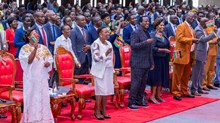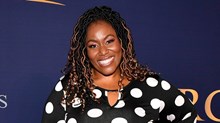What was Oral Roberts's main legacy? How important a figure was he? Oral Roberts University president Mark Rutland told CT that he and Billy Graham "were the two preeminent luminaries of the 20th century."
Preeminent historian of Pentecostalism Grant Wacker, author of Heaven Below, largely agrees.
"Other than Billy Graham and Martin Luther King Jr., and maybe Jerry Falwell, it would be hard to name a different religious leader of more importance," he told USA Today. "In the middle of the 20th century, he took faith healing and Pentecostalism away from a frowzy backwoods image and gave it an upbeat face."
Wacker is (justifiably) ubiquitous in the obituaries today. He told The Washington Post, "If we set aside Billy Graham and Martin Luther King and [Jerry] Falwell in the sense that their influence was religious but also political and social, outside them Roberts was the most important religious figure in the second half of the 20th Century. Just as a religious figure. And in lots of ways. The most obvious way was he brought Pentecostalism out of the backwoods and made it respectable. One cannot imagine the modern day Pentecostalism without him. He transformed its image, but also its practice."
Mark Silk, director of the Greenberg Center for the Study of Religion in Public Life, isn't so sure. "It's the respectability thing I wonder about," he said of Wacker's assessment. "Roberts' signal contribution to Pentecostal teaching was the Prosperity Gospel—the idea that turning your life over to Jesus and doing good would make you rich in the things of this world. Adherents of this teaching around the world are legion. But, it seems to me, among the cultured despisers of Pentecostalism—religious and secular alike—it's as unrespectable as any Holy Roller ever was."
The New York Timesmakes the same claim: "He was the patriarch of the 'prosperity gospel,' a theology that promotes the idea that Christians who pray and donate with sufficient fervency will be rewarded with health, wealth and happiness."
But Silk and the Times may be confusing Roberts and another Tulsa resident, Kenneth Hagin, who is far more widely recognized as the man who joined Pentecostalism with the Faith Movement (also called "Word-Faith," or derogatively, the Prosperity Gospel or "Health and Wealth" gospel). Many scholars would credit Baptist E. W. Kenyon as the father of the teaching, and many other names would be more closely associated with it than Roberts (Kenneth Copeland, for example). The Dictionary of Christianity in America explicitly states that Roberts is "not fully identified with the movement [but] has close doctrinal and personal ties with many faith teachers." And in fact one of the first major critics of the Word-Faith movement was an Oral Roberts University theology professor, Charles Farah. (ORU's Howard Ervin was another vocal critic.)
"Most charismatics, including Roberts, acknowledged that his theology had never agreed with that of the faith teachers—there had always been more room in Oral's thought for paradox and the inscrutable," David Edwin Harrell wrote in his authoritative biography, Oral Roberts: An American Life.
More or less. The first of Roberts's 130+ books, after all, was titled, If You Need Healing—Do These Things! Harrell acknowledges that Oral's beliefs "were not far from those of the moderate faith teachers," but argues that his identification with them was more in "a return to his cultural roots" and had little to do with theology. "Partly, he was drawn to them and other successful independent religious leaders because he identified with their struggles," Harrell said.
Those struggles were not those of sex and money. They were of perceived religious bigotry and intolerance. Roberts's longtime effort was to be God's conduit for healing ("God heals; I don't," said the man who did not like being called a "faith healer") and saving souls. But it was also to be accepted by mainstream American Christianity and by the world at large.
The desire comes across clearly in David Wolpe's recollection of his day visiting with Roberts at ORU. When Wolpe praised The New York Times, he writes, "Rev. Roberts took that opportunity to ask his question. With a genuinely anguished look he said, 'Can you explain why they hate us?'"
The key moment that ignited this desire, according to Harrell, came about because of this magazine. In 1966, Billy Graham invited Roberts to be a part of the Christianity Today-sponsored Berlin Congress on World Evangelism. His opening prayer became a turning point in the meeting and (according to friend and Oklahoma pastor Warren Hultgren) the turning point of Roberts's life. CT reported that he
won a significant measure of new respect through the congress. He made a host of friends among delegates who were openly impressed with his candor and humility. When a panel got around to discussing over-emphasis on healing, Roberts readily acknowledged that he made "some mistakes" in the past. He indicated to a plenary session that he wanted to be identified more with mainstream Christianity.
Two years later Roberts transferred his religious affiliation from the Pentecostal Holiness Church to the United Methodist Church, and in 1969 he decided to stop televising revival services and instead put on prime-time variety shows featuring mainstream celebrities.
Respect aside, it certainly brought him attention. A 1972 Time article, noting one of Roberts's Easter specials, starring Mission: Impossible's Peter Graves, Jane Powell, and Harve Presnell, called Roberts "the real superstar" of the show. "The fast-paced, free-spending ambience of his television tapings, his casual, almost paternal confidence with his guest stars, his natty pinstripes and carefully barbered sideburns are only a few of the signs that the country boy from Pontotoc County, Okla.—who knocked down his last tent in 1968—has left the sawdust trail for good," the magazine said.
Leaving the sawdust trail was a ticket to recognition—64 million viewers tuned in to the shows, and by 1980, 21 out of every 25 Americans knew his name.
Still, this magazine was never as enthusiastic as it had been in 1966. It repeatedly (invariably) used the word "slithering" to describe the dancers on Roberts's variety show, and noted that he had earned "frowns from members of the evangelical old guard who might view it all as a bit too avant-garde, too hip."
More than four decades later, Roberts's use of celebrities (even non-Christian ones) has become standard not just in Christian media, but in Christian conferences and even churches.
And no doubt a lot of what might have been controversial about Roberts at one time is now deeply embedded even in the evangelical churches that like to criticize Word-Faith preachers. Healing ministries, once relegated to Pentecostal churches of the "sawdust trail" sort, are now common in churches across the theological spectrum.
Even Roberts's dream of a national basketball championship (to reach the "40 million men who read the sports pages," he told Time in 1972) has come close in recent years: ORU's team has appeared (albeit briefly) in the last three Men's Division I Basketball Tournaments.
But still, Roberts always seemed to be dismissed as a "faith healer" by both evangelical gatekeepers and the mainstream media. And that, says Harrell, is one of the reasons why Roberts turned back to associating with Word-Faith preachers later in life.
"Oral was more culturally at home [at the Hagin camp meetings] in a way he would never be in a Methodist church," he wrote. "To some extent, Hagin had reintroduced Roberts to the burgeoning charismatic movement he had done so much to create. In a time when his ties to the Methodist church were shaky, the independent charismatic revivalists showed Oral a whole new constituency that loved and honored him."
It was to that constituency and other Pentecostals that Roberts appealed for the remainder of his life, as he was (somewhat inaccurately) tied to the televangelism scandals of the 1980s and the rise of the "religious right," and as he faced economic troubles regarding the City of Faith Medical and Research Center (it closed in 1989).
So when Roberts's 1987 fundraising warning made headlines and late-night talk-show monologues, it tended to cement views of Roberts that were already in place, and ultimately is a footnote to Roberts's story.
As Wacker told the Associated Press, "For true believers it made sense. For the rest of us, it was like, 'Well, all right. This is an embarrassment. Let's move on.' I don't think there's any question it was an embarrassment for millions of Pentecostals. But overall it is so minor, measured against the magnitude of his accomplishment."
Copyright © 2009 Christianity Today. Click for reprint information.
Related Elsewhere:
Earlier articles on Oral Roberts and Oral Roberts University include:
Q+A: Mark Rutland on Oral Roberts's Legacy | The Oral Roberts University president reflects on a man who had a big vision. (Dec. 16, 2009)
God's Man in Tulsa: The Life and Ministry of the Original Televangelist | Oral Roberts was a larger-than-life figure in American Christianity. By Roger Olson (Dec. 16,2009)
Healing ORU | $70 million and Mart Green's business acumen are repairing a scandal-scarred school. (September 3, 2009)
Fund Raising: Did Oral Roberts Go Too Far? | The television evangelist links receiving $8 million to the extension of his early life. (February 20, 1987)

Support Our Work
Subscribe to CT for less than $4.25/month


















